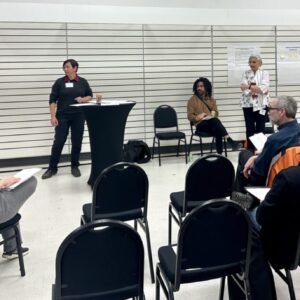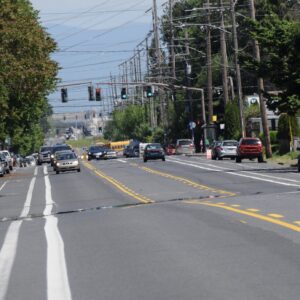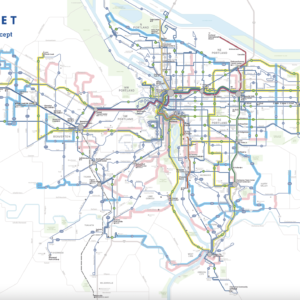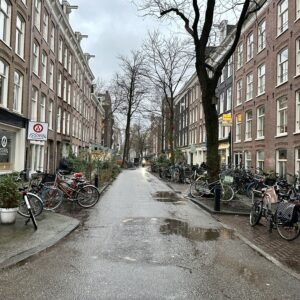
Tillamook, are safer for families.
File photo: 3/31/07
As part of a course on Community Development, a group of Portland State University students are helping the BTA plan a bicycle boulevard network in north and northeast Portland.
They’ve developed a short survey to identify streets that might be candidates for development into bicycle boulevards. According to one of the project leaders,
“This input will constitute the rough data, as we will take piecemeal stretches of bike-friendly roads and connect them together in a network plan.”
This project runs through the end of May and the students plan to deliver their findings to the BTA by June.
If you ride in and around north and northeast Portland, please take a few seconds to offer your insights into which streets would make good bicycle boulevards (check Wikipedia for more on bicycle boulevards).





Thanks for reading.
BikePortland has served this community with independent community journalism since 2005. We rely on subscriptions from readers like you to survive. Your financial support is vital in keeping this valuable resource alive and well.
Please subscribe today to strengthen and expand our work.
One thing I would like to see is to fix some of the potholes and rough sections on the skidmore bike boulevard that is already there. That or move the boulevard to a street that is in better repair. Parts of it in the cully neighborhood and east of cully are approaching a gravel road.
Also does anyone, perhaps someone with the BTA have data on how much safer bike boulevards actually are? I mean they feel safer but are they safer for bicyclists than other nearby low traffic roads or are they just faster because they have fewer stop signs? I’m curious because if they really are statistically safer than it seems odd that we would have traffic enforcement actions that target them.
Bjorn
Biking on residential roads is boring. And then, there’s the terrain to consider. It often seems the major motor vehicle roads have smoother grades. Personally, I’d rather see more bike lanes on the few contiguous, level roads in north and northeast than bike boulevards on the hilly, residential, disjointed side streets. While I appreciate the safety consideration, I’m not sure the roads in my neighborhood are made for that kind of set-up. Maybe we could use a shared car/bike lane (I think there’s one like it in NW on 19th)… something that is signaled to let cars know they are sharing the road… personally, I am pretty sure that I am gonna be biking down Fremont and 7th regardless.
This may be a bit self-serving since I live on this street, but N. Bryant would be a great NoPo east/west blvd especially since it has the super-secret pedestrian bridge crossing I-5. It also then links up with Willamette heading to St. Johns.
greg, I think you’ll find that there are plenty of people who would rather ride on those “boring” residential roads than in a bike lane, myself included.
I’ll leave my own ranting about bike lanes out of this for the sake of brevity. And I certainly disagree that most residential streets are disjointed. If anything does make them feel disjointed, it’s the stop signs every other block, something that bike boulevards are designed to eliminate.
Keep in mind also that bike boulevards are MUCH more family friendlly than bike lanes.
I agree with tonyt.
Riding on busy streets is a viable choice only for faster, more fit cyclists. I am not about to take my 7 year old son on anything but the quietest street I can find. Nor am I going to take my 2 year old daughter in a trailer on Fremont.
The purpose of bike boulevards is to provide better access for the non-lycra cyclist or the person who would cycle, but sees main roads as dangerous.
Providing a safe, convenient, dedicated road will be the difference between driving and leaving the car at home for many people who see cycling as too dangerous under current circumstances.
Bjorn,
Boulevards are probably just as safe as adjacent residential streets, however because of the traffic calming and other enhancements, they tend to be more efficient for cyclists going thru an area.
We also think it’s odd that bicycle boulevards have been the target of recent enforcement actions given that there are many, far more dangerous roadways and intersections throughout the city.
Emily Gardner
Bicycle Transportation Alliance
Readers…remember that bike blvds are NOT a direct replacement for bike lanes but a route option for those who do not wish to ride on bike lanes…which usually have more traffic and higher speeds and congestion.
The true key to usability of bike blvds is how well they conveniently cross arterials – in addition to route signing and networking.
These crossings often need more physical improvements (refuges or signalization) than a bike lane facility on a parallel arterial…due to the dispropriate levels of traffic volume vs. the planning priority of the bike blvd (a higher facility type on the hierarchy of streets than the cross car traffic should be in many cases).
Todd- I’m not a City Planner (but I play one on tv), so help me out:
“These crossings often need more physical improvements (refuges or signalization) than a bike lane facility on a parallel arterial…due to the dispropriate levels of traffic volume vs. the planning priority of the bike blvd (a higher facility type on the hierarchy of streets than the cross car traffic should be in many cases).”
I think what you’re saying is that a bike blvd (aka “facility”) should be considered a higher priority for traffic planning purposes than the cross-streets (which mostly carry cars). But that often they’re not prioritized higher, and therefore don’t have signals or whathaveyou, causing cyclists to have to scamper across the heavy-traffic streets.
Did I get that right? I’m thinking of NE Tillamook at 15th as an example (although 15th is only two lanes; but a very busy two lanes at times!).
I love commuting on bike boulevards. My only complaint is that they could all use more signage. Cyclists are able to easily see and understand the little circle markings on the road. However, they are too small and their meaning is not understood by a majority of drivers I come across. Bike boulevards are incredibly safe, but only if the car drivers understand that they should find an alternative route if they don’t want to drive slowly behind a bike.
I agree with Options Guy, crossing a busy two lane road is dangerous on a bike. Especially when there is a left turn car facing you across the intersection because it is hard to know if they will yield. During peak hours, 37th and Fremont and 37th and Killingsworth also fall into this category.
bjorn said:
One thing I would like to see is to fix some of the potholes and rough sections on the skidmore bike boulevard that is already there. That or move the boulevard to a street that is in better repair.
three words: Going, Going, Going.
i don’t know what they were smoking when they made NE Skidmore the official bike route. NE Going is quieter, wider, nicer looking, straighter, has a more gradual incline for easier uphill biking, is better-paved … superior in every respect except for three things:
1) there’s no light at MLK & Going … that’s probably why there’s so much less car traffic on it. If the city wanted to install a bike-light there I’d use it, but actually with the way the nearby lights are timed, I don’t ever seem to have trouble crossing there.
2) to cross Vancouver headed north on Going involves swimming upstream half a block — the wrong way on a one way street. fun for me, deadly for grandma.
3) at N. Gantenbein, Going turns into a sidewalk for three blocks! Who knew? it would make a *stellar* bike bath, if only there were curb cuts and some kind of ramp at the west end. Then it could feed into Prescott or whatever.
anyway, with those three things fixed it’d be the most kick-ass East/West route in NE & North Portland. as it is, it’s still better than Skidmore.
I’d like to see a greater investment in BOTH bike boulevards on the quieter streets and some better bike infrastructure on the busier-but-widely-used-by-bikes streets.
A good example, I think, is NE 9th north of Broadway and NE 7th between Weidler and Alberta.
9th is supposedly a bike route, on paper at least, but the pavement is in bad shape and the stop signs need to be turned east and west. You also go through Irving Park, which is fine for the casual rider, but I don’t think many commuters use it. Good bike boulevard potential.
7th, on the other hand, is widely used (I ride it every day and see lots of us) but could desperately use sharrows along the whole route north of the Lloyd District bike lanes, and some signage on the traffic circles: something to the effect of “share the road” or even just a bicycle symbol. This would open up some space for us on that street, particularly around the circles, which can be pretty dangerous, and I don’t think it would be very expensive. Some speed enforcement would be welcome every once in awhile, too. Not to mention that planned bridge over I-84!
My question is, instead of turning so much of our attention to “bike boulevards”, why not do a more holistic analysis on bike/car flow and figure out appropriate treatments street by street?
In this case, do some upgrades on 9th to make it a legit bike boulevard and make it more appealing to those who want a more peaceful ride, and do some minimal work on 7th to make it a safer ride for those who already use it.
I think sharrows would be helpful on Skidmore as well, between MLK and the MAX station. And how about some of those nice directional/mileage signs on Skidmore while we’re at it (you know, like “MAX station 1 mile”, “Mississippi 1/2 mile”, etc)?
Just put a 2 lane bike boulevard down I-5, clean up the center of I-205 for the same, I-405, and I-84…easy. Then add some bridged off ramps and watch bicycle-ship thrive.
I second N. Bryant (and not just because I live close to there also :)). Looking at a map Bryant connects well with Willamette Blvd, goes by Arbor Lodge park, and uses the ped bridge that might have some earmarked money for an upgrade from the I-5 widening.
Mike
I’d like to back up a little bit and discuss what exactly makes a bike blvd.
Jonathan, maybe you can help with this.
My thought is “sharrows do not a bike blvd make.” There’s got to be more to it than painting something on the road.
When I think of a bike blvd, I think of something like SE Ankeny, where there are barriers at certain intersections that allow bikes to pass through but force cars to turn. This eliminates cars using the street as a through street, while allowing car driving residents and customers to still access the street where they need to.
As a side note, I use N. Michigan as my major N/S route to and from NoPo and frankly I like that it is in somewhat “ill-repair” in some spots. My impression is that the road condition acts as a traffic calming device and gives cars an incentive to get over to Albina. Fix that section of Michigan and I’d bet money that cars would start ripping down there.
This talk about making east Portland more bike friendly makes me a little frustrated. It’s like adding trees to the forest. Sure, the forest could always use more trees, but honestly, how many does in need?
I dream about living in E PDX so I can basically leave the car in the garage 80% of the time. Unfortunately I live in SW and being a two-wheel fan out here SUCKS. When is someone going to conduct a study to make SW more bike friendly? I’m surrounded by fast, hilly streets with no shoulder and drivers who would probably hide my body in the bushes.
I third the N. Bryant idea, and Delaware makes a great perpendicular connector street.
Bjorn,
If you need potholes fixed, just call the pothole hotline:
“To report a pothole within the City of Portland’s jurisdiction, leave a message with the following information: street location, nearest cross street or block address, your name and phone number.”
Contact: Pothole Hotline
Phone: (503) 823-BUMP
tonyt,
you’re right. bike blvds are much more than just sharrows and bike lanes.
And I agree, N. Michigan ave. is my main N/S connector to downtown. It’s a tough call on the potholes. I agree they calm traffic, but they are also a bummer to ride over all the time…especially with (sometimes sad) kids bouncing around in a trailer!
Jake,
I hear your pain about SW conditions…but you’re in luck! There’s a large effort afoot to make things better. Here are a few stories I’ve covered about it:
—SW Trails steps up bike planning efforts
—Southwest bike network map shows potential
Much thanks, Jonathan. I checked out both postings and e-mailed Mr. Baack, offering my help in anyway with the SW Trails project. SW is just one of those places where the combination of commuters and hills makes it particularly bad…which is why a bike “boulevard” or trail a la springwater would be so great. Then I might actually get my wife out on her spanking new two-year old bike.
I also think Going going going. Skidmore is nice but the hills are pretty steep for family riders. Skidmore crossing 15th is much than visability than 15th and Going. The lights at Prescott and Alberta create pretty good traffic gaps.
I think we need a Physically seperated lane for bikes from the SE Goodwill all the way to Broadway/Weidler. Biking in that very commercial area is difficult to say the least. It would also create easier access to the East side Esplinade.
JayS.
I think that too many bike boulevards is travesty.
We are supposed to be able to “Share The Road”, and putting too big of a emphasis on bike boulevards is not doing that at all.
I recommend that you take the main road, and assert your authority on it.
If you cannot ride the main road much, maybe due to family, or being slower or elderly, that is one thing.
But we need to maintain a presence on the main arterials.
Hiding on little side streets, riding in and out of the shadows is not going to do it.
No one is saying we all need to or should hide on little streets. Even when riding with my kids there are points when I have to join the main arterials ie. crossing bridges. More Blvds= more options=more riders. More thinking about the blvds should also help to create better facilities in those places where we must all share the road.
I’m an opportunist when I ride. I may be headed in one direction, but I’ll immediately make a turn if the road ahead looks bad (or the side road looks inviting). When my family rides with me, they constantly ask, “where are YOU going?”
I can do this partly because I don’t mind traffic and I know my way around. Even so, I wouldn’t mind having bike blvds, and I know they would really help novice and infrequent riders. To every one who wrote that blvds should be long straight streets with gentle grades, RIGHT ON!
Parting shot on bike lanes. They’re fantastic, but
1. Car tires toss all street debris (glass, stones, pipes!) into the bike lane.
2. How about them potholes? (we need a local bike racing team to call itself the Portland Pothole Dodgers)
And the cars expect me to drive through all of this crap, no matter how unsafe it is, b/c its a BIKE LANE!
I get it now. Bike boulevards are not for the likes of me, but they can serve a valuable purpose for some bike riders and for timid, would-be riders. I guess my concern is that I read about a lot of motorists and bus drivers suggesting that we need to get bikes off the main roads and onto “bike boulevards”– it needs to be made clear that for quick, efficient commuting, often the car-trafficked roads are the best roads for bikes too and we maintain our right and desire to use them. I think sharrows along those busier routes, like 7th in particular, could help make it clear that bike boulevards are alternatives; not a form of vehicle segregation.
Greg says it very well, and people who are used to using bikes to travel in E Portland (where there are many options to get where you are going) are going to have a lighter attitude about the use of bike boulevards.
However, not everyone has the choice between the “fast” route or the “scenic” route. Some people live in places where the attitude of “asserting yourself” is a physically daunting one. And while one might feel empowered by this attitude, it could get you hurt or killed. So, while we should never give up our right to use any road we choose, we also need alternatives to high-speed, hilly, narrow and otherwise dangerous commutes.
tonyt, #14: “When I think of a bike blvd, I think of something like SE Ankeny, where there are barriers at certain intersections that allow bikes to pass through but force cars to turn. This eliminates cars using the street as a through street, while allowing car driving residents and customers to still access the street where they need to.”
I think of SE Clinton, which IMHO is the best bike boulevard around, and should be the model for all others — except for at SE 34th, where a traffic circle should replace the 4-way stop. (Maybe ditto for the other stop signs, including those at 26th and 21st…)
That is, it has three main characteristics (not counting pavement quality, slope, street width, connectivity, etc.):
1) Stops signs on cross streets but not on the bike boulevard except at key intersections.
2) Traffic circles every few blocks to slow down cars.
3) A signal and intersection at SE 39th that prevents cars from entering the bike boulvard (though allowing them to turn right or left to leave), but allowing bicycle/pedestrian through-traffic.
I think Ankeny is basically set up this way, too, but for whatever reason, I enjoy riding on Clinton more. Go figure.
What is a bicycle boulevard?
There are a couple of different ways to look at boulevards.
At PDOT we define a bicycle boulevard as a low volume (under 3,000 cars per day), low speed street that already works pretty well for bicycles. We (the city) make improvements to make them work better. These improvemenets typically include:
moving stop signs so that traffic along the boulevard flows relatively uninterrupted; treatments to simplify and ease the crossing of intersecting collector streets (median refuges, curb extensions, bike-ped only signals), and traffic calming to slow down cars.
Title 16 of the City Code defines a bicycle boulevard as: “A roadway with low vehicle traffic volumes where the movement of bicycles is given priority.”
Ideally, a bicycle boulevard is a street with superb bicycle facilities and on which all people interested in bicycling will feel safe and comfortable.
This is not to detract from bicycle lanes. But, not all potential cylcists are willing to ride in lanes. Here’s one strategy: If we can first get a majority of Portland residents out and about on bicycle boulevards, where they’ll gain experience and become more comfortable riding–and more determined to keep riding–eventually they’ll feel comfortable one lanes and other higher volume roadways.
Of course, boulevards have great value beyond being “training facilities.” I’m comfortable riding on most streets in Portland and use a bicycle almost exclusively for getting around town. Nonetheless, I almost always find myself gravitating to the boulevards and other low-volume streets simply because I find them to be the most enjoyable places to ride.on than our boulevards.
A lot of great input here. I don’t think anyone has mentioned Killingsworth and Ainsworth, so I’m going to chime in.
Killingsworth and Ainsworth are both great arterial east-west streets (close to each other)
Ainsworth could be a great bike blvd., but that doesn’t mean that Killingsworth doesn’t need a bike lane as well.
I hope we can do both.
(I do realize Killingsworth has a bike lane, but as far as I can tell it only goes for a few blocks, I hope there are already plans to complete it.)
Maybe it’s time to reopen the discussion on designating bike boulevards carfree or local car traffic only:
http://bikeportland.org/2006/11/20/should-bike-boulevards-be-car-free/
Elly,
I think we’d have much more success if we shot for local car traffic rather than no cars.
I live on Bryant and I’d fight hard to make it a bike blvd if that meant limiting it to local cars. If the goal was NO car traffic, I have to say I would not be in favor of that.
A few comments:
— I believe one reason the bike “dots” that mark the boulevards are smallish is because they don’t want to make them too obvious to cars — if you were driving your car instead of riding your bike, wouldn’t you want to find the through route with fewer stop signs, too?
— I believe the traffic circles on Clinton, NE 21st, NE 24th, etc are not a favorite of the Fire Bureau folks because they slow them down in responding to calls, and it’s my suspicion that we won’t see any more built like these (I can’t think of any that have been built in the last 10 years or so)
— NE Emerson (one block south of Killingsworth) from 14th to 33rd (New Seasons) and on to 41st would be great alternative to Killingsworth were it not for a couple of blocks of unimproved streets between 27th and 29th; also if it wasn’t for some unmatched platting at 14th it could even continue further west to MLK and beyond
— PDOT is getting ready to start redoing the N Killingsworth streetscape from Interstate to Commercial (minus the area around PCC, which has already been done); it won’t get bike lines (no room for them, I’m guessing) but it will get curb extensions and crosswalk improvements
— Jake – I almost would trade some of your westside forest for some of our rather treeless areas over here on the “great white porkchop” of NE Portland; remember that those trees are also slowing traffic (this is proven)
— I agree with Dabby… as our numbers increase, we will be getting back, so to speak our “share” of the road more; this is something that Roger Geller touched upon in response to a question at the brown bag today (though not in those exact words, of course); there have been times recently where there’s been a line of 9 bikes coming into town off the Broadway Bridge, and I have taken a car lane to pass; I also figure a car is less likely to try and run me back into the bike lane if there are more bikes around; (and there’s your “critical mass” with 10 bikes, being effective)